北京(3月)│ソウル(5月)│北京(6月)│北京・鞍山・盤錦(8月)│ソウル(11月)│北京(11月)
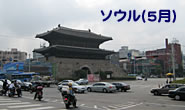 2007年5月:ソウル
2007年5月:ソウル
5月29日┃5月30日┃5月31日┃6月1日┃地図
【5月30日】 ソウル城郭
6時起床。シャワーを浴びて7時散歩に出る。
ソウルの観光案内地図で見るとホテルの前に建つ東大門の奥から北にソウル城郭が延びている。万里の長城のようになっているのだろうか見に行くことにした。
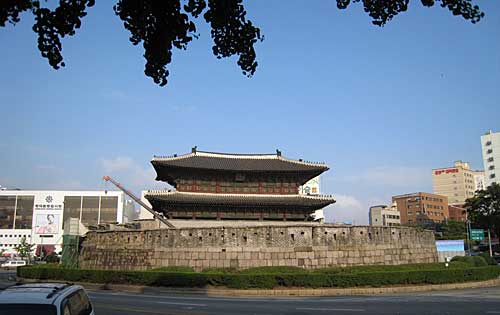 |
| ホテルの真ん前に建つ改修工事中の東大門。 |
7時を過ぎたとはいえ道路は既に交通ラッシュで交通整理をする警察官の笛がひっきりなしになっている。地下鉄1号線東大門駅の上を横切るように横断歩道を渡り、地図で見当をつけた細い坂道に入る。少し上ると車と交通整理の笛の音が届かなくなり周囲の緑が都会の真ん中にいることを忘れさせる。
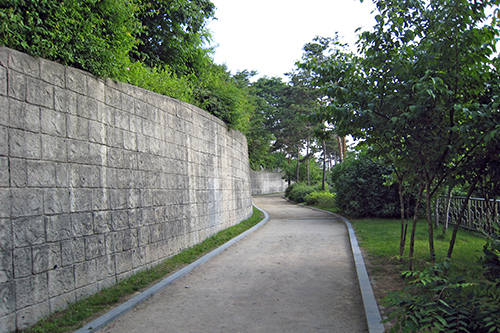 |
| 遊歩道のような坂道。 |
歩き始めるとさすがにジンワリと汗ばんでくる。ときおり健康のために歩いている人にすれ違う。左側を見上げると城壁のような壁が見える。
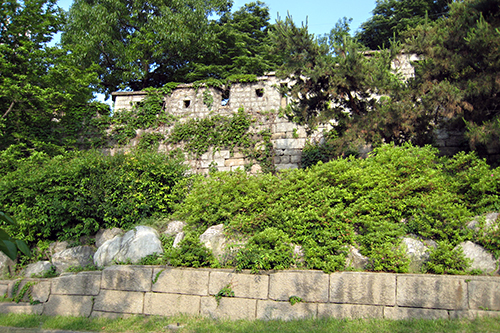 |
| 城壁跡。 |
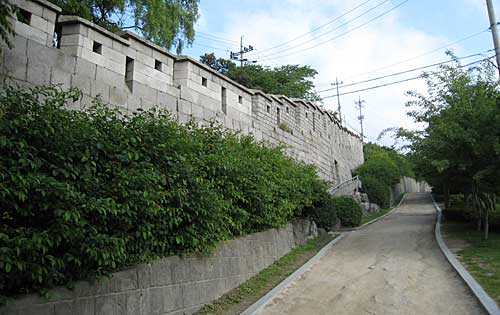 |
| 復元されたソウル城郭。 |
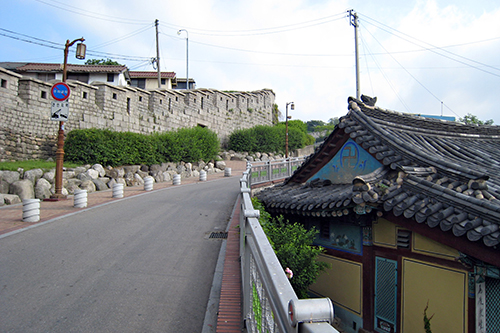 |
| 城郭に沿って坂道を上り切る。 |
丘の上にNaksanの説明があったので一寸長くて所々誤植があるが原文のまま紹介する。
|
Naksan (Mt.)
Naksan was also called Naktasan, or Camel
Mountain, as it's peak is shaped like the humped back of a camel,
Naksan is located in the eastern part of Seoul, stretching to Jongno-gu,
Dongdaemun-gu and Seongbuk-gu compared with Inwangsan to the west. (注:下線部分は原文のまま。) |
城郭の所々に設置されているソウル城郭の説明板にはハングルと英語に続いて日本語があったので、これもそのまま紹介する。
|
ソウル城郭
指定番号:史跡第10号 この城郭は、朝鮮第1代王、太祖が、戦争への備えとして、また盗賊を防ぐために作った城郭である。太祖5年(1396)に20万人を動員して築き、第4代王、世宗4年(1422)に城郭を全て石で再建すると同時に、弓や鉄砲が使える施設を造った。その後何度かにわたる補修工事が行われた。 |
Naksanを下りながら城郭の内側っだった西側を歩く。城の外を覗くと直ぐ下に石垣に沿ってに歩いてきた道が見下ろせる。日本語の説明版にある弓や鉄砲用の四角い穴が模様のように開いている。
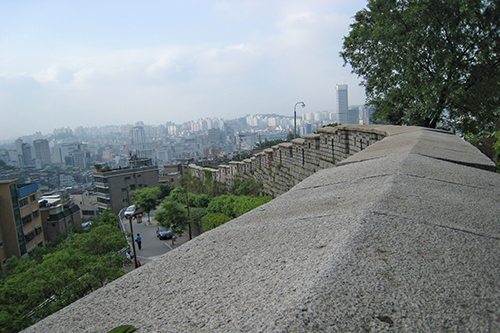 |
| 城郭の左側の道を上ってきた。 |
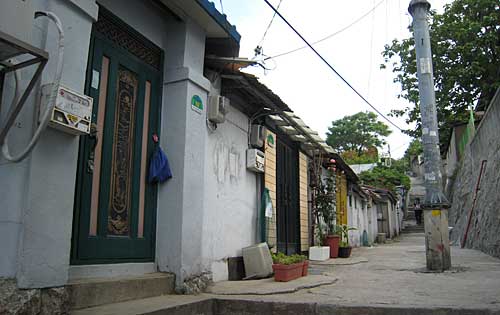 |
| 城郭に沿って並ぶ民家。 |
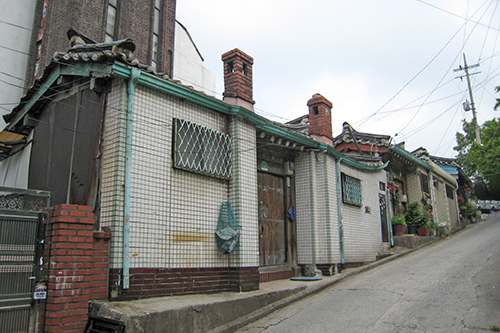 |
| 門柱の上はオンドルの煙突。 |
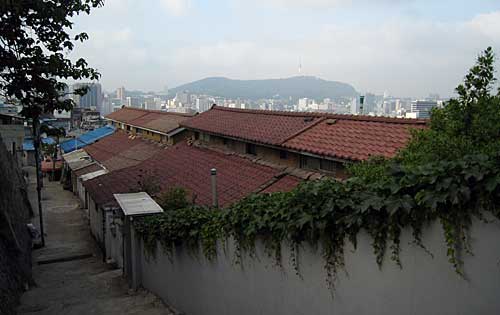 |
| 振り返ると民家の赤い瓦屋根の向こうに繁華街のビルが覗いている。 |
丘の斜面に並ぶ古い家々の間を細い露地が縫う。この露地に入っていっても出て行く先の検討がつかないので諦めてもとの所に戻ること数回。
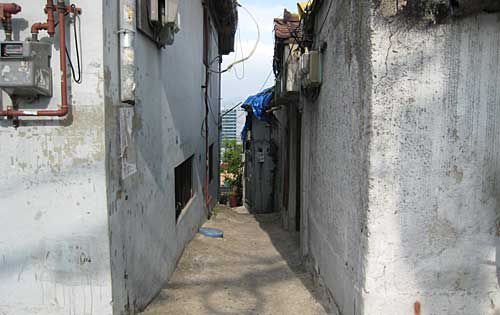 |
| こんな細い露地が迷路のように丘を下ってゆく。 |
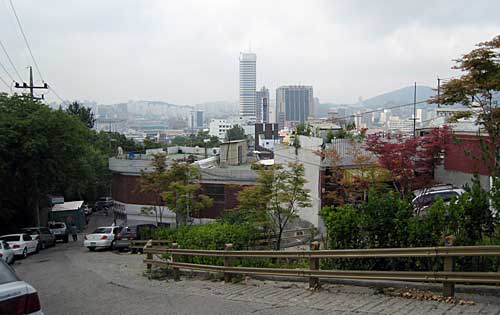 |
| この坂道を下りてゆくと大きな教会の横に出た。 |
ソウル市内を歩いているとよく教会に出会うが、この丘の途中にある中央聖潔教会は大きな教会だ。斜面を削って整地して建てられているが駐車場の造成も含めればずいぶん資金が必要だったろう。
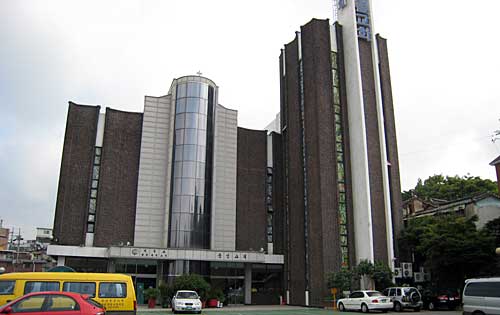 |
| 中央聖潔教会。 |
教会の横をさらに下りてゆくと下を地下鉄4号線が走る栗谷路に出た。栗谷路の緩い坂道を左に行くと東大門の前に出た。交差点を挟んでBest Western Hotel Dongdaemunの反対側に出たようだ。
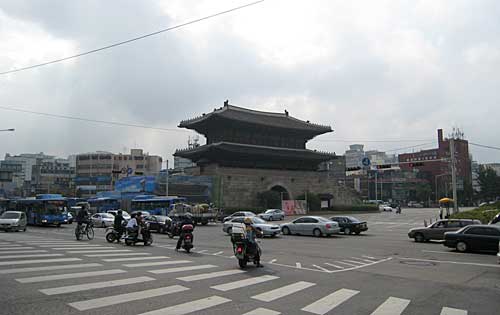 |
| こちらが表側になる東大門。 |
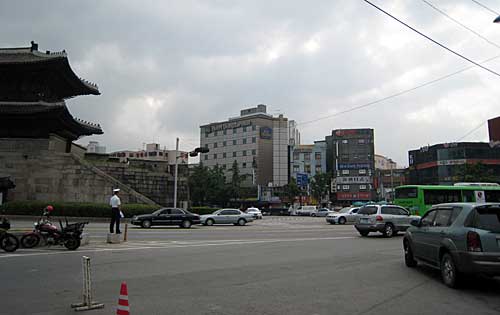 |
| 東大門の右奥に見えるのがBest Western Hotel Dongdaemun。 |
9時を少し過ぎている。さすがに腹が減ったのでホテルの裏通り、昨夜夕食を食べたと同じ通りに行ってみる。昨夜夕食に入った『パースンチ』の斜め前に清潔そうな小さな店があったので入ってみた。店の名前は『トンヘラン食堂』。『パースンチ』のお母さんより少し若目のお母さんが一人で切り盛りしていた。
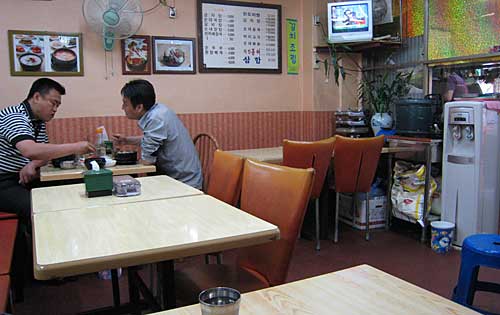 |
| 清潔な店内は先客二人がのんびりと食事をしていた。 |
壁に貼ってある写真を指さして「ジャガイモ、おいしいよ。」と勧めるので頼んだ料理の名前は『カムジャタン』。こちらは豚肉の背骨の辺りのことを言うらしい。昨夜のものとは少し味が違うようだ。ノンビリ食べていたら9時半を過ぎてしまった。
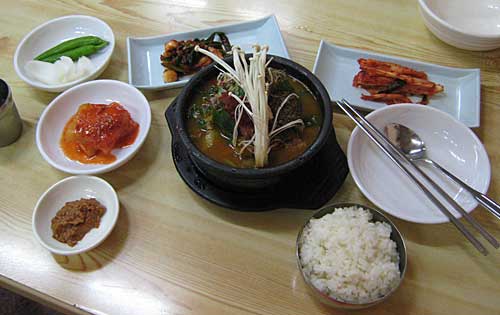 |
| 家にいるときには考えられない質とボリュームの朝食。 |
あわててホテルに戻りシャワーを浴びて地下鉄でサンドルに向かう。ホテル前の地下道で地下鉄4号線の東大門駅から一駅乗れば恵化駅。ホームも地下鉄の車内もラッシュアワーを過ぎたからか空いている。
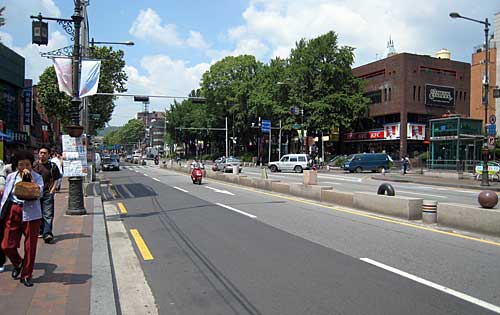 |
| 恵化駅を下りて地上に出ると大学路だ。 |
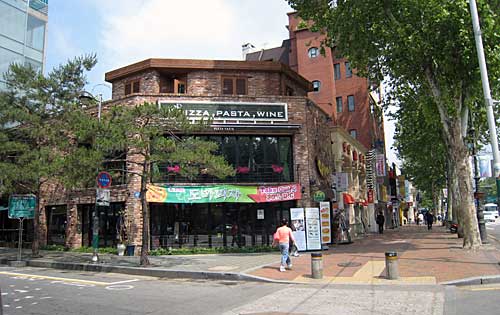 |
| このPiza・Pasta・Wine屋を目印に左に折れる。 |
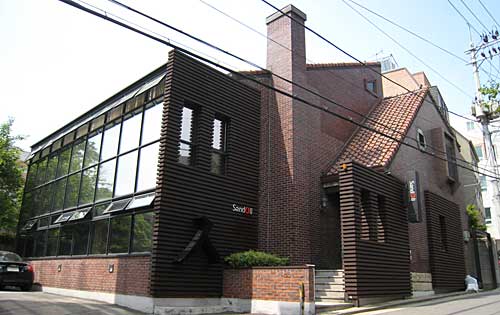 |
| 民家を買い取って社屋にしているサンドル社。 |
サンドル社に着いたときは20分の遅刻。会議室には既にKimさん、Koさん、Cheさん、Hoさんが待っていた。
12時半まで会議。昼食に出ようとして玄関でセオク社長に会い挨拶する。
会議出席者全員で大学路を渡りマロニエ公園北側に広がるレストラン街で韓国の家庭料理『辛氏火爐』に入りランチ。
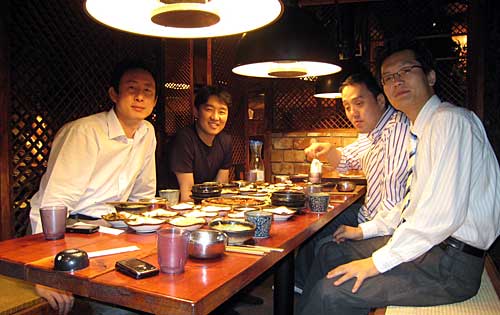 |
| 左からKoさん、Cheさん、Hoさん、Kimさん。 |
2時過ぎから5時まで会議再開。営業会議終了後はフォント・デザインチームと談笑。みんな研究熱心で人なつこい若いデザイナーだ。明日の予定をBruceさん、Hoさんと打合せをしてから地下鉄でホテルに戻る。
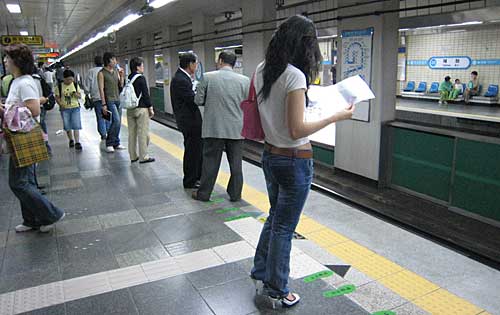 |
| 恵化駅ホーム。電車はホームの右手から入ってくる。 |
7時にホテルのロビーでBruceさん、Hoさん他サンドルのフォントチームと落ち合い外出。
ホテルから歩いて清渓川を渡りオガンスギョ交差点角の背の高いファッションビル"Doota Tower"(トウサンタワー)に入る。入り口から出てくる人、入る人は皆若い人たちばかりで女性の姿が圧倒的に多い。一人で店内を歩くのが気後れするくらいだ。
10階の"LAVE ROCK BEER PUB"で乾杯。
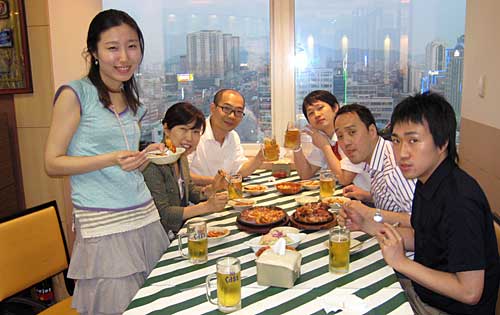 |
| 左からChaさん、Zhaiさん、Bruceさん、Zhai Cheさん、Leeさん、Lee Dokyungさん。 |
それぞれの仕事の話、家族の話、将来の希望と広がる話題は尽きず。9時半を過ぎて皆お腹も一杯になり話疲れてきたところで"LAVE ROCK
BEER PUB"を出る。今夜は若い皆さんにご馳走になってしまった。Doota Towerの前で皆と別れ一人ホテルに戻る。
ホテル一階ロビーのPCが空いていたのでウエブブラウザーで私用メールをチェック。返事が必要なメールが何本かあったが、このPCは日本語IMEが設定されていない。インストールしたくてもメニューがハングルでは手も足も出ない。仕方なくローマ字で返事を書いたが何十年ぶりのローマ字だろう。帰ったらきっとあの返事は何なんだって言われるだろうな。